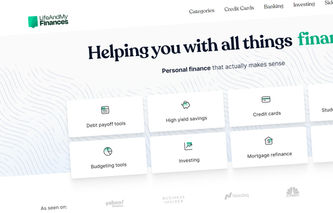Let’s get this straight—millionaires are made, not born. Ramsey Solution’s survey of over 10,000 millionaires revealed that 79% didn’t receive any inheritance from their parents or other family members. They got there through hard work and investing.
And, according to Credit Suisse, the US had 2.5 million new millionaires in 2021 alone. So, with $200,000 to invest, you could be next in line.
Wondering what your options are?
Here’s a table explaining your investment options and what you can expect to make from them.
We’ve broken down investment types from the most to the least volatile and risky.
We’ll cover everything form cryptocurrency (arguably the riskiest pick) all the way to money market funds, the safest players:
INVESTMENT TYPE | EXPECTED EARNINGS (30 YEARS: 1993–2023) | EXPECTED EARNINGS (2022–23) | TIME NEEDED TO TURN $200K TO $1M (BASED ON 30-YEAR RETURNS) |
Cryptocurrency (^BTC) | 48.29% (from 2014) | -28.86% | 4–6 years |
Stock market (SPY) | 9.73% (from 1994) | -8.11% | 17–20 years |
Private equity (PEX) | 2.90% (from 2013) | -15.25% | 55–60 years |
Collectibles (Wine) | 32.9% (from 2019) | 1.8% | 6–8 years |
Real estate | 17% (from 2013) | 19.2% | 10–13 years |
Solo 401(k) (VWINX) | 7.60% | -5.12% | 20–25 years |
Individual retirement accounts (VTTSX) | 8.86% (from 2013) | -8.29% | 17–20 years |
Bonds (BND) | 2.67% (from 2008) | -7.58% | 60–70 years |
Certificate of Deposit (CD) | 1.43% | 1.47% | 110–120 years |
High-yield savings accounts | 3.43% (from 2001) | 4.00% | 50–60 years |
Money market funds | 2.30% | 2.53% | 70–80 years |
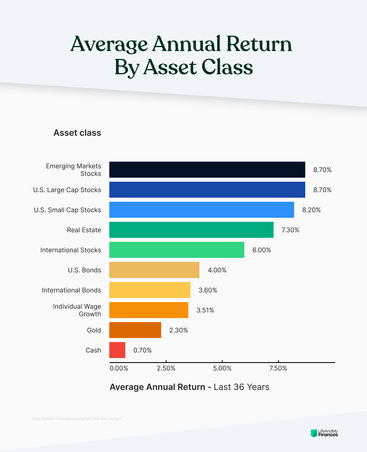
All set to start investing? We’ve scoured the market and thoroughly reviewed all investment apps to make things easier for you.
Want more options and all the geeky details? Read our detailed ranking of the best investment apps.
And now for the detailed breakdown—
1. Cryptocurrency
Expected earnings based on historical data (^BTC): 48.29%
Young and thin—we think that’s an accurate way to describe the cryptocurrency market.
The world is still learning to invest, grow, and regulate this niche.
But you don’t have to watch on the side-lines. Consider spending a small part of your $200k on getting started on your crypto investment journey.
Cryptocurrency is any digital currency in which the transactions are verified, and records are kept by a decentralized system using cryptography.
Right now, leading cryptocurrencies on the market include Bitcoin, Ethereum, and Litecoin.
Here are some statistics that put the success of cryptocurrency into perspective:
The global crypto market cap reached $863 billion in November 2022.
The price of Bitcoin went up by over 540,000% in 2012–2022.
Singapore-based blockchain firm Triple A claims that 320 million people worldwide used or owned cryptocurrencies in 2022.
Keep in mind:
Cryptocurrencies are very volatile digital assets. This means higher highs and lower lows. Given the infant stage of cryptocurrencies, crypto projects can easily collapse—we’ve recently witnessed this with the FTX scandal.
Cybersecurity is another major consideration with any crypto investment. With the industry being marred with security breaches, investors should know how to secure their investments with hardware wallets.
Charlton Haupt, Founder and CEO of Bad Astro Society, thinks the fallout of the FTX scandal has many investors asking themselves what they need to consider while betting on crypto.
While sharing tips, he says,
Many investors will purchase their crypto on an exchange and leave it there for convenience. You want to avoid this at all costs and store your crypto in a hardware wallet. Secondly, investors should use multiple exchanges at a time for their orders. This will diversify the risk should one exchange go down while you are in the middle of a trade. I personally know someone who had an exchange go bust, but he diversified with other exchanges and didn't suffer a devastating loss.
Charlton Haupt Founder and CEO of Bad Astro Society
How to invest: first steps
Interested in crypto but too overwhelmed to invest? You’re missing out. Start by investing in one of the top cryptocurrency exchanges in the US: Coinbase.
Thanks to the app’s video classes you won’t get swamped by 170+ cryptocurrencies on the platform. And the Coinbase wallet will keep all your crypto and NFTs safe.
Check out our top recommendations to start investing:
Looking for more options? Read our complete list of the best crypto apps for more.
Suggested further reading:
2. Stock market
Expected earnings based on historical data (SPY): 9.73%
More Americans own pets than stocks. That’s 70% of American households with little furry creatures vs. 53% of American families investing in the stock market.
Here’s a more bewildering fact: CNBC’s 2021 report found that the wealthiest 10% of Americans own a record 89% of all US stocks.
So if you’re on the wrong side of these stats, it’s time to start investing.
There are different levels of stocks you can invest in:
Global stock funds invest primarily in foreign companies (these may include US companies).
International stock funds generally limit their investments to companies outside of the US.
Regional or country funds invest in companies located in a particular geographical region, such as Asia or Europe (or in a single country like China).
Sector stocks are groups of stocks that have a lot in common with each other, usually because they are in similar industries.
Individual stocks are stocks of a particular company. Investing in them gives you complete control over where your money goes.
Here are some key types of stocks to keep in mind:
Exchange-Traded Funds (ETFs) have a more diversified portfolio than investing in individual stocks. They can be a great entry point into the stock market for new investors.
Dividend stocks can be great if you’re looking for lower-risk investments. Here, companies share a part of their profits with shareholders, so you have two sources of returns—regular dividend payments and the stock’s actual value.
Index funds are mutual funds or ETFs that build portfolios to match certain market indexes, such as the S&P 500 or Dow Jones Industrial Average. Buying an index fund gives you access to a broad range of holdings. These funds also tend to have low management fees, meaning more money goes towards investing.
Mutual funds hold a portfolio of stocks, bonds, or other securities. Active mutual funds aim to outperform the market, making them more unpredictable than index funds.
Keep in mind:
Investing in individual stocks can be time-consuming, as you’ll have to thoroughly research and evaluate the stock market before buying them. Check out our investment guides for more.
How to invest: first steps
We get it—navigating the stock trading world is challenging. And finding the right app is definitely half the challenge.
We’re making things easy for you with our top picks:
Looking for more options? Check out our full ranking of the best stock apps here.
Suggested further reading:
3. Certificate of Deposit (CD)
Expected earnings based on historical data: 1.43%
CDs are a type of account offered by banks and credit unions, earning interest on your money for a set period. They typically pay a fixed rate of return for the duration of your term.
CDs are a good investment option for long-term goals or for money you’re comfortable locking away for some time. This also makes it the perfect vehicle to hold your emergency fund.
Keep in mind:
Budget to see how much money you can set aside for a CD account—if this is your emergency fund, ensure you’re putting aside enough for six months of basic expenses.
Don’t spend your emergency fund on incidental expenses.
How to invest: first steps
CD accounts now have rates ranges between 4% and 5%. Start an account in leading banks such as Capital One and State Exchange Bank for attractive interest earnings.
Suggested further reading:
4. Private equity
Expected earnings based on historical data (PEX): 2.90%
Private equity attracts many investors because of its potential to fetch large returns. Angel investors with plenty of capital can usually figure out which start-up to bet on because of their connections.
But don’t let these entry barriers stop you from investing in businesses—all thanks to crowdfunding.
Keep in mind:
The best thing about equity investments is their potential to fetch massive returns (if you’re able to invest in a business early on, and it grows into a large corporation).
The risk of start-up failure is significant. Consider the risk of being diluted down, and how long your money can be locked up in shares.
If you don’t already have a solid foundation for your portfolio, investing a large part of your $200k fund in private equity may be too risky.
How to invest: first steps
Check out Moonfare—a digital private equity platform that collects assets from private investors into feeder funds, which are then invested directly into underlying PE funds.
Platforms like SeedInvest, OurCrowd, and Yieldstreet also let you invest in promising start-ups across various industries.
These are equity-based investments, so you’re essentially buying ownership in a company on the same terms as established angel investors.
Suggested further reading:
5. Collectibles
Expected earnings based on historical data (Liv-ex Fine Wine 100 Index): 32.9%
Collectibles can mean anything of value that people collect. And no, that doesn’t include the crockery set you bought last Christmas.
Here’s a more specific definition: Collectibles are items worth more now than when you bought them.
This includes art, antiques, wine, stamps, books, coins, trading cards, and more. The rarer something is, the higher its resale value.
Some collectibles aren’t easy to categorize. From Ty Cobb’s dentures to Justin Bieber’s hair—a lot of weird stuff has been sold to collectors with unique tastes.
But here’s the thing—regardless of what you’re looking to buy, collectibles are expensive. And you don’t want to be spending all of your $200,000 on a painting.
The solution? Consider investing using a platform like Masterworks.
It is the first platform for buying and selling shares representing an investment in iconic artworks. You can own a piece of an iconic painting, just like you own stocks in a company.
Masterworks also gives you access to expertly-vetted artworks, meaning you can avoid fakes—a common problem faced by collectors.
Not keen on investing in art? Check out Yieldstreet, a platform that empowers investors to grow their wealth outside the stock market by curating private market alternatives.
You can invest in anything from private business credit, real estate, legal finance, and so on.
Keep in mind:
Collectibles are alternative investments. They’re not bonds, stocks, ETFs, mutual funds, or cash.
If your collectible appreciates in value, you’ll have to pay a whopping 28% capital gains tax on its sale.
Counterfeits and frauds are common in the collectibles world.
Since it’s usually tough to sell collectibles at short notice, you may face liquidity issues.
How to invest: first steps
Start with the most stable categories—investing in fine wine has achieved 10.6% annualized returns over the past 30 years.
Begin your wine journey with Vinovest. The platform lets you own the wines in your portfolio outright—so you can buy, sell, and drink them whenever you want.
Investing in contemporary art has also produced 7.5% annualized returns since 1985.
You can start with a platform like Masterworks. It lets you buy and sell shares representing an investment in iconic artworks.
 Yieldstreet 4.3 | 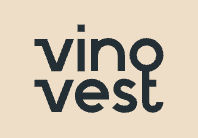 Vinovest 4.1 |  Masterworks 3.9 |
Trading fee $0 0% to 2.5% management fee. Flat annual fee from $100–$150 in the first year and $30–$70 every following year. | Trading fee $0 | Trading fee $0 |
Account minimum $2,500 | Account minimum $1,000 | Account minimum $15,000 |
Promotion None No sign-up bonus, but you can earn $100 per referral. | Promotion None | Promotion None |
Suggested further reading:
6. Real estate
Expected earnings based on historical data (CrowdStreet): 17%
Most wealth managers and experts will ask you to invest in real estate. This comes with varying degrees of risk, and is one of the best ways to invest $200k for passive income.
A study by the Federal Reserve Bank of San Francisco and the University of California showed that real estate had offered the highest returns of any asset class over the last 145 years.
To that end, REITs have historically delivered high returns.
In fact, a comparison between S&P 500 and the FTSE Nareit All Equity REITs Index reveals that REITs have outperformed the S&P 500 over the past 20, 25, and 50-year periods.
However, the high returns faltered in 2020 as REITs decoupled from the stock market.
Currently, the valuations on a number of REITs is historically low (especially office and retail REITs).
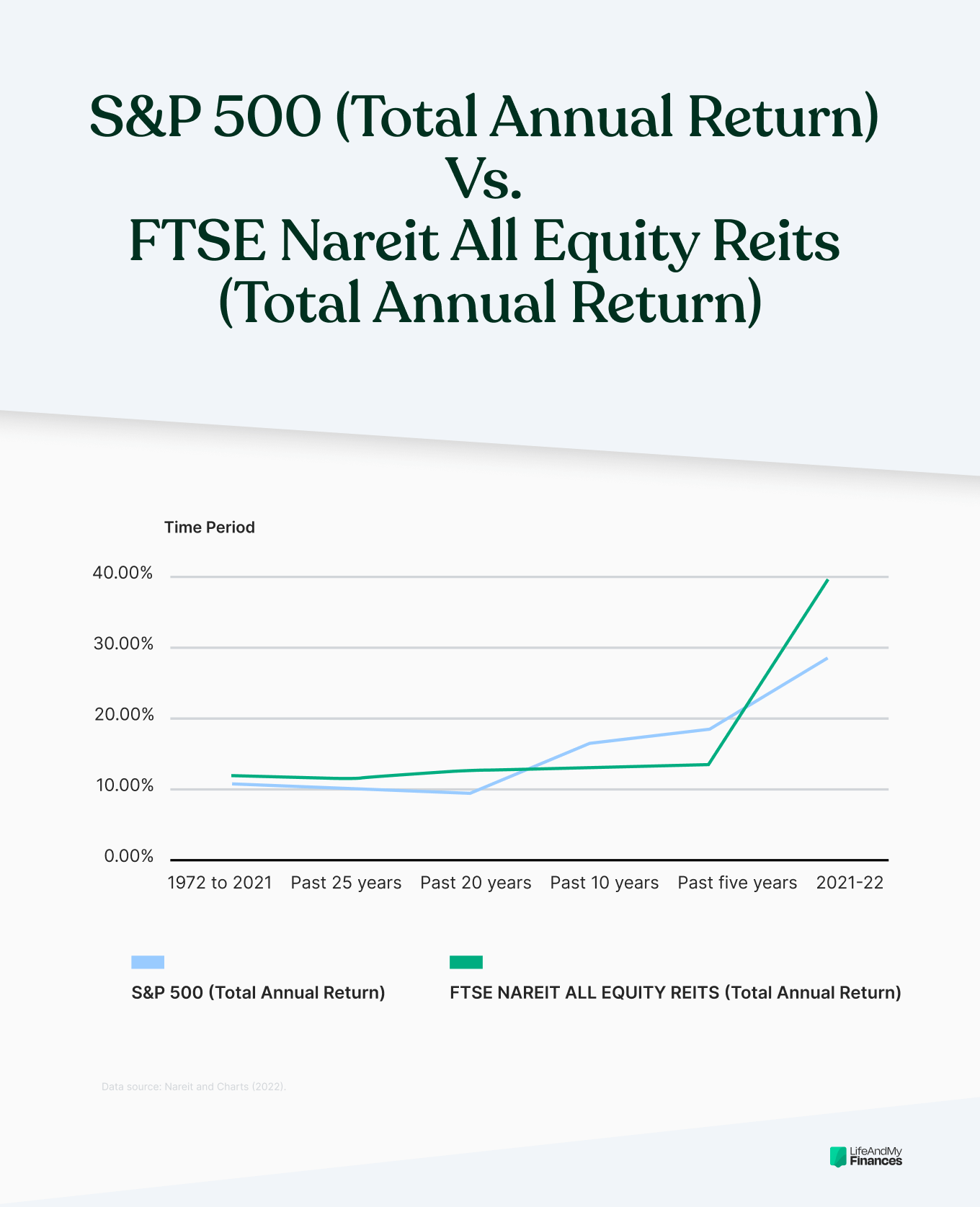
Wondering how to invest $200k in real estate? If you think $200,000 isn’t enough capital, you couldn’t be more wrong.
Here are some tips on how to invest 200k in property:
Invest in REITs (Real Estate Investment Trusts): These are usually companies owning commercial real estate (such as retail spaces, office buildings, apartments, and hotels). They let you invest in real estate without becoming a landlord—which is why they’re often compared to mutual funds.
REITs tend to:
Pay high and stable dividends (they’re required to distribute at least 90% of their taxable income to their shareholders annually).
Provide long-term total returns.
Offer liquidity as shares of publicly-listed REITs are readily traded on the major stock exchanges.
Reduce your portfolio’s overall volatility.
Invest in fractional real estate: Fractional real estate investors own a small portion of expensive real estate properties. You can use online real estate investing platforms to fund developers looking to finance their projects through debt or equity.
Flip real estate: House flipping can be lucrative—you can buy an underpriced house, renovate it, and resell it for a profit.
Consider rental properties: The iGMS Annual Forecast Report says the short-term rental market has seen a 21% increase in demand in 2022. You can buy a property and convert it into a vacation rental.
Keep in mind:
Some real estate investing platforms may need you to be an accredited investor. The Securities and Exchange Commission defines an accredited investor as someone who has earned an income of over $200,000 ($300,000 with a spouse) in each of the last two years or has a net worth of $1 million or more (this excludes the value of their primary residence).
The location of your real estate can determine the returns you make on it.
How to invest: first steps
Invest with a reputed crowdfunding platform like Fundrise.
With a whopping $7+ billion real estate portfolio, it claims to have provided its clients with average annual returns of 5.40% in 2022.
 Crowdstreet 4.1 |  Yieldstreet 4.3 |  Fundrise 4.3 |
Trading fee $0 | Trading fee $0 0% to 2.5% management fee. Flat annual fee from $100–$150 in the first year and $30–$70 every following year. | Trading fee $0 |
Minimum $25,000 | Account minimum $2,500 | Account minimum $10 |
Promotion None | Promotion None No sign-up bonus, but you can earn $100 per referral. | Promotion $10 Invest $10 and earn $10 worth of shares in the Fundrise Real Estate Interval Fund. |
Suggested further reading:
7. Solo 401(k)
Expected earnings based on historical data (VWINX): 7.60%
A solo 401(k) plan lets a one-person business set up a 401(k) through a brokerage platform, and save up to $20,500 (if you’re under 50) in 2022 as elective deferrals.
The investment goal here is usually long-term growth.
Investing in solo 401(k) can also give you access to tax deductions. You can choose to make tax-deductible deferrals or tax-free Roth deferrals.
Keep in mind:
To qualify for a Solo 401(k), you can’t have any employees (other than your spouse).
If your account has more than $250,000 in assets, you’ll need to file an annual report on Form 5500-SF.
You can only withdraw your funds when you reach the age of 59.5 (55 in some cases).
How to invest: first steps
You can open a solo 401(k) with an online broker like Vanguard, though you’ll need an Employer Identification Number.
The broker will offer you a plan adoption agreement as well as an account application to complete.
You’ll then have access to many of the investments offered by your broker, including mutual funds, index funds, ETFs, individual stocks and bonds.
Suggested further reading:
8. Individual retirement accounts
Expected earnings based on historical data (VTTSX): 8.86%
If you’re self-employed without a company retirement plan, this one is for you.
Individual retirement accounts (IRAs) provide tax-deferred growth for your investments, and are a must-have for long-term investing.
You can invest in two types of individual retirement accounts (IRA):
Roth IRA: Pay taxes on contributions, and get access to tax-free withdrawals later.
Traditional IRA: Deduct contributions upfront, and pay taxes on withdrawals you make later.
Both options offer great benefits—but it makes sense to choose an account based on your expected tax bracket at retirement age.
If you expect a higher income at retirement, go with Roth IRAs—you don’t have to pay taxes on your withdrawals at that time.
Keep in mind:
Many financial experts say that retirement income should be about 80% of a couple’s final pre-retirement annual earnings. Even an employer-sponsored 401k may not be enough for that—making IRAs more attractive.
The 2022 contribution limit for both IRAs is $6,000 ($7,000 if you’re 50 or older).
Roth IRAs have income restrictions, while anyone with earned income can contribute to traditional IRAs.
How to invest: first steps
Open an online IRA in less than five minutes with SoFi Invest® and save for retirement with SoFi’s active or automated Traditional, Roth, and SEP IRAs.
A SoFi account will also give you access to a broad range of investment options, member services, and several planning and investment tools.
You can also move your existing 401k to an IRA with SoFi’s rollover options.
Suggested further reading:
9. Bonds
Expected earnings based on historical data (BND): 2.67%
Governments and private companies use bonds to raise money from investors. But what do you get in return? The bond issuer will pay you back with interest over time.
You can invest your $200k in three different types of bonds:
Corporate bonds: Companies use these to raise money for expansion or development. These bonds are taxable, but they usually fetch you higher yields.
Municipal bonds: The state can use these bonds to raise money for public projects like hospitals, schools, or roads. You don’t have to pay federal tax on the interest you earn from these bonds. Obligation municipal bonds will fund non-revenue-generating projects like a playground—while revenue municipal bonds can fund revenue-generating projects such as highways.
Treasury bonds: Also known as T-bonds, are essentially risk-free as the US government issues them. You have to pay federal tax on Treasury bonds, but you’re exempt from state and local taxes.
Keep in mind:
Bond investors are experiencing large paper losses because of inflation. In his recent New York Times opinion piece, Jeff Sommer, the author of Strategies, outlined how US bond returns were the worst ever recorded in 2022.
David Rosenberg of Rosenberg Research points out that Treasury bonds will be the best asset class in 2023, considering the impending recession.
How to invest: first steps
You can buy bonds from an online broker—and learn how to open a brokerage account to get started.
This way, you’ll be buying bonds from other investors looking to sell. Start with top online brokers like Robinhood and J.P Morgan.
Suggested further reading:
10. High-yield savings accounts
Expected earnings based on historical data (NEWT): 3.43%
Some of your $200k can go into a savings account.
You may want to choose a high-yield one since they pay higher interest rates than regular ones.
Growing your funds in an FDIC-insured savings account is virtually risk-free. You can also easily access your funds, though some savings accounts limit withdrawals.
Keep in mind:
While choosing a high-yield account, compare:
Minimum deposit amount
Annual percentage rates
Minimum balance amount
Withdrawal options
Interest rates can fluctuate at any time.
How to invest: first steps
The national average for interest on savings accounts is 0.24% APY. But a high-yield savings account can fetch you upwards of 4% APY.
Wondering which bank to pick? We’ve researched, reviewed, vetted, and re-vetted banks across the US to help you make the right call.
Here are our recommendations for the best high-yield savings accounts:
Want more options? Choose from the list of the best high-yield savings accounts here.
Suggested further reading:
11. Money market funds
Expected earnings based on historical data: 2.30%
Money market funds are low-risk investments, and are one of the best ways to invest 200k short-term.
These fixed-income mutual funds invest in debt securities with short maturities and minimal credit risk.
Depending on the type of securities the funds have invested in, your income can be taxable or not.
A money market fund can invest in debt-based financial instruments, including:
US Treasuries: short-term government debt issues.
Repurchase agreements (Repo): short-term government securities.
Bankers’ Acceptances (BA): short-term debt guaranteed by a commercial bank.
Certificates of Deposit (CDs): savings certificates issued by banks with short-term maturity.
Commercial paper: short-term unsecured corporate debt.
Categories of money market funds based on what they invest in:
Prime money funds invest mainly in floating-rate debt and commercial paper of non-Treasury assets.
Government money funds invest 99.5% or more of total assets in very liquid investments, like cash, government securities, and repurchase agreements fully collateralized by government securities.
Treasury funds invest in short-term US government debt securities, such as Treasury bills, Treasury bonds, and Treasury notes.
Tax-exempt money funds mainly consist of municipal bonds and provide earnings free from federal income tax.
Keep in mind:
Money market funds aren’t insured by the Federal Deposit Insurance Corporation (FDIC).
These are short-term investments that give lower returns, meaning your rate of return might not keep pace with inflation.
How to invest: first steps
You can purchase money market funds in a few different ways.
You can go directly to a fund provider such as Vanguard or BlackRock, purchase them through a bank, or through your online brokerage account.
You’ll likely have the most options through an online broker who will have funds available from a number of different providers.
Suggested further reading:
Bonus 1: Start a Business
Expected earnings based on historical data: 10% net profit on small businesses
Have a business idea you put on the back burner? Now may be the time to bring it to life. The risk you’re taking (and the capital you’ll need) will vary depending on your business idea.
According to the US Small Business Administration, most microbusinesses need around $3,000 to kick things off (most home-based franchises will need $2,000–$5,000).
With $200,000 in the bag, you can certainly afford to start a small to mid-size business.
Some key expenses you should take into account:
Office space
Licenses and permits
Insurance costs
Inventory
Website building
Advertising and marketing
Employee salaries
Keep in mind
Starting a business is time-consuming—and it can take months (even years) to fetch a significant return.
There’s a high risk of failure. Startup Genome’s Global Startup Ecosystem Report 2019 says nine out of ten startups fail.
A successful business has great wealth-building potential, as you can sell your assets for capital gains in the future.
How to invest: first steps
Look for a business mentor or a local SCORE group.
SCORE is a non-profit organization with a vast network of volunteer business mentors and specialists to assist you with your business plan.
Also, leverage the US Small Business Administration’s Small Business Development Centers, which offer free business consulting and assistance.
Suggested further reading:
Bonus 2: Invest in yourself
While it may sound like something you’d read on QuotesLyfe.com, this is a serious investment—so let’s talk numbers.
The World Economic Forum tells us that wide-scale investment in upskilling can boost GDP by $6.5 trillion by 2030.
That’s nice for the economy—but what does that mean at an individual level?
A study on upskilling by Gallup and Amazon says American workers who recently participated in an upskilling program saw an average salary increase of 8.6%.
Simply put, upskilling can help you make more money.
Keep in mind:
Upskilling without a strategy can be a wasteful effort—narrow down on your goal for upskilling:
Do you want a promotion?
A better job?
Or start something of your own?
Once you have your goal, figure out your blind spots—the essential skills you lack to achieve your goal. Then invest a part of your $200,000 in the right resources.
Check out MasterClass today to learn new skills from the best in the business.
MasterClass is a streaming platform that allows anyone to watch or listen to hundreds of video lessons taught by more than 180 of the world’s best.
MasterClass delivers a world-class online learning experience—whether in business and leadership, photography, cooking, writing, acting, music, sports and more.
Suggested further reading:
How to Turn 200k Into a Million
We’ve looked at 11 different ways you can invest your $200k.
Here’s an example of a balanced portfolio of a $200k investment for 20 years:
INVESTMENT AVENUE | % INVESTED | AMOUNT INVESTED | RETURNS AFTER 20 YEARS |
S&P 500 index fund | 30% of $200k | $60,000 | $403,649 |
Real estate | 15% of $200k | $30,000 | $116,090 |
Savings account | 10% of $200k | $20,000 | $21,024 |
Private equity | 10% of $200k | $20,000 | $327,330 |
Short-term corporate bond | 15% of $200k | $30,000 | $65,733 |
Individual Retirement Account (IRA) | 15% of $200k | $30,000 | $139,828 |
Total returns at the end of 20 years | $1,073,654 | ||
Tips on How to Invest 200k to Make $1 Million
These tips can help you stay on top of your investing game:
1. Know your finances
Before you invest that $200,000, think about where you are in your finances right now.
Do you have an emergency fund in place?
Are you overspending?
Do you have debt that is high in interest or won’t be paid off with your regular income?
Check if there’s anything more important you need to take care of with your $200k (like a high-interest debt that’s costing you thousands of dollars each month).
Deal with the most financially pressing stuff, and then start investing.
2. Decide on your goals
It’s important to know what your financial goals are.
Want to earn money each month? Consider investing in passive income revenue streams.
Want to retire with a fat wad of cash? Invest in riskier stocks or options with higher rates of returns.
3. Start investing early
Are you financially stable, but waiting for the right time to start investing? The right time is now.
Here’s the thing—the sooner you invest, the more chance your money has to grow.
Investing earlier in life can earn you an extra few thousand in interest alone.
4. Make Sure Your Investments Are Diversified
Investing only in one type of niche, industry, or sector can be devastating to your finances if that market dips.
Diversify your investments instead.
Look into passive investments, real estate, and even different types of stocks. That way, if anything happens to some of your money, the rest will be safe.
Key Takeaways
WHETHER YOU’RE INVESTING $1 MILLION OR 200K, LOOK AT YOUR FINANCIAL SITUATION. ARE THERE ANY ISSUES YOU NEED TO DEAL WITH RIGHT AWAY? MAKE SURE EVERYTHING ELSE IS IN ORDER BEFORE INVESTING LIQUID MONEY.
Remember, no investment strategy will assure a profit or protect against loss. The best thing to do is to have a diversified portfolio.
And we’ve listed out 11 different ways you can do just that.




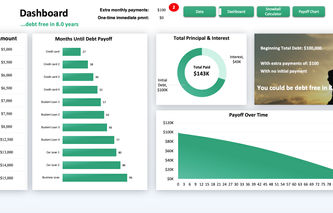
.jpg)
